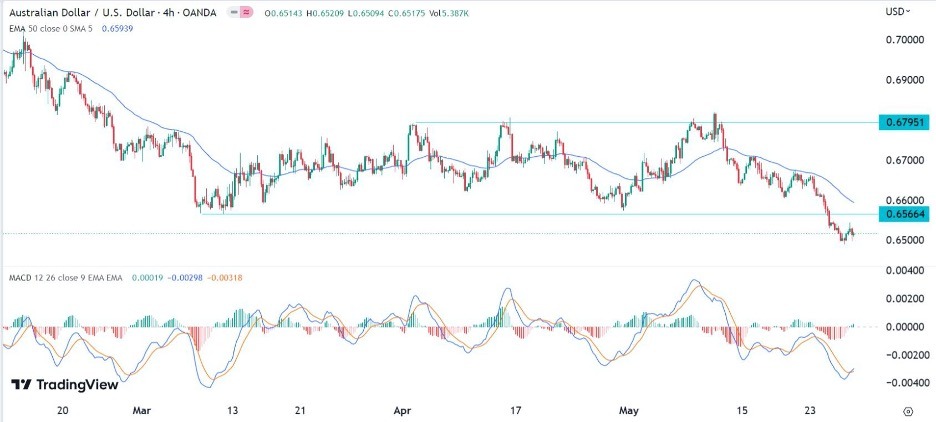[ad_1]
There will be no catalyst for the AUD/USD pair on Monday, with the US markets being closed for the Memorial weekend.
- Sell the AUD/USD pair and set a take-profit at 0.6450.
- Add a stop-loss at 0.6585.
- Timeline: 1-2 days.
- Set a buy-stop at 0.6565 and a take-profit at 0.6625.
- Add a stop-loss at 0.6465.
The AUD/USD pair continued falling after the relatively strong US PCE data and the positive outlook on the debt ceiling issue. It retreated to a multi-week low of 0.6491, which was much lower than this month’s high of 0.6817.
Inflation in the United States is still sticky. On Friday, data by the Bureau of Economic Analysis showed that the personal-consumption expenditure index rose by 0.4% in April, higher than what analysts were expecting. The figure jumped by 4.4% from the same period in 2022. Core PCE also jumped by 4.7%.
Therefore, there is a likelihood that the Federal Reserve will likely continue hiking interest rates in its June meeting. Minutes published last week showed that some Fed members were comfortable with higher rate hikes.
There are some other catalysts for higher rates. For example, the crisis in the regional banking sector seems to be ending. Highly risky banks like PacWest and Comerica have seen their shares jump by more than 20% from the lowest level this year.
Meanwhile, there are signs that the debt ceiling deal hammered between Democrats and Republicans during the weekend. The deal will see the US raise the debt ceiling until 2025 and set caps on non-defense spending.
It is still unclear whether the House of Representatives and the Senate will pass the deal this week. If it passes, it will eliminate the likelihood that the US will default on its debt obligations in June.
There will be no catalyst for the AUD/USD pair on Monday, with the US markets being closed for the Memorial weekend.
Looking forward, the key data to watch this week will be the upcoming US consumer confidence data and non-farm payrolls (NFP) data. It will also react to key numbers like Australia’s inflation and retail sales data.
The Australian dollar has been in a bearish trend in the past few days after it peaked at 0.6818 on May 10. It has moved below the important support level at 0.6566, the lowest level on April 28 and March 10. The pair has dropped below the 50-period moving average while the MACD indicator has dropped below the neutral point.
Therefore, the pair will likely continue falling in the coming days as sellers target the next key support at 0.6450.
 Ready to trade our daily Forex signals? Here’s a list of some of the best Forex platforms Australia to check out.
Ready to trade our daily Forex signals? Here’s a list of some of the best Forex platforms Australia to check out.
[ad_2]